30 Cycling Photography Tips and Ideas

30 Cycling Photography Tips & Ideas
Taking cycling photography like a real pro won’t be a problem if you study the following helpful tips, tricks and ideas.
1. Do a Little Research on Cycling Photography Genre

Even if you already know something about cycling, it won’t hurt to expand your knowledge. Learn in more detail about this sport and how the shooting is carried out. In this way, you will be thoroughly prepared for the actual photoshoot. You may start your research by watching YouTube video tutorials about cycling. Also, you may find books specifically about cycling photography, for instance, Graham Watson’s “40 Years of Cycling Photography”.
2. Choose an Interesting Location

There exist two types of cycling photo shoots. The first one involves photographing cyclists that compete in a pre-arranged race, which means that you don’t have to pick a location. The second type, posed shooting, requires the search of a captivating location and planning a cycling trip.
I recommend looking for remarkable locations at Adventure Cycling's Route Network or U.S. Bicycle Route System.
3. Pay Attention to Backgrounds

It doesn’t matter whether you shoot a cycling race or a trip, you can always turn any place into a stunning background. In case of a static bike photograph, it isn’t so difficult to achieve an entirely decent composition. But if you feel like including the background for the dynamic shot, you shouldn’t forget about the proper framing of the scene.
Use a wide-angle lens with a small aperture (f/11-f/16) to achieve a deep DOF. This lens is known for providing a broader angle of view, which no human eye is able to perceive in real life, only when it is captured in photographs.
4. Experiment With Different Perspectives

The chosen perspective and shooting angle have a great impact on the composition of your bike race photography. There no perfect angle for this or any other genre, you should try different ones. When you experiment with perspectives and angles, you will be able to see what looks good or not and pick the most flattering photograph.
5. Do Not Forget About Important Pictures

Certain types of shots are obligatory for cycling photography. You should capture the main details of the location, the viewers and their emotions. With the help of such shots, you will reflect the general atmosphere and the vibe of the race.
6. Focus on Details
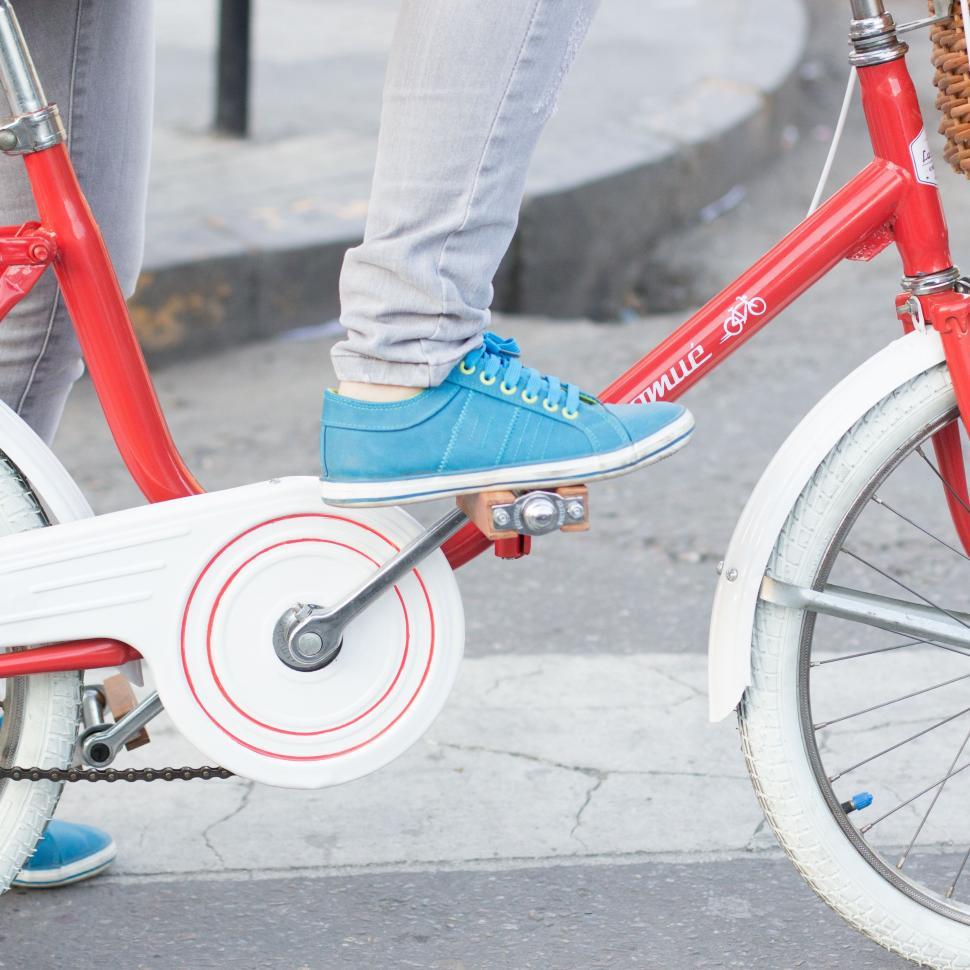
If you think of cyclist portraits, a full-body picture is more likely to come to your mind. But it isn’t the only possible angle for shooting. The most effective trick to attract the viewers’ attention is to demonstrate different pictures, involving small elements.
Capture the cyclists’ clothes, hair, legs or any other detail. As a result, because of such a focused emphasis on the details, the shots will turn out more memorable, truly unusual and will make the viewers wonder.
7. Keep Track of the Cyclists’ Faces


When taking bike ride photography, concentrate on the cyclists’ faces for some time, namely on their facial expressions. Human emotions are the essence of any kind of sports photography. If you have managed to capture a variety of emotions on the cyclists’ faces, such pictures are bound to be successful.
8. Use a DSLR
Since cycling is such a varied sport type, different cycling events and environments call for different shooting gear. Many shooters state that the best camera for cycling photography is Canon 1DX. This full-frame model will help you take pictures of incredible quality both in decent lighting conditions, shadows and low light. It boasts a remarkable ISO range, image processors and praiseworthy 18MP CMOS sensor.
In case you typically photograph in RAW format, the image detail and quality are sure to impress you!
- Pay attention to these cameras for sport photography
9. Pick Different Lenses for Different Cycling Events
During the regular street cycling shooting, when you want to capture the cyclist or the bicycle, I suggest using the standard zoom or prime lens. For shooting such cyclins events as velodrome trials or BMX races, a telephoto lens, for instance, Canon EF 100-400mm Telephoto Zoom Lens is required. To take a picture of a cyclist in its surroundings, pick a wide-angle lens, for instance, EF 35mm f/2 IS USM lens. As the lenses I have mentioned are bulky enough, a monopod or a tripod to hold them is a necessity.
10. At Least 1/500th

What to do when the perfect moment for shooting comes? In case you want to capture the cyclist in motion, stick to fast shutter speed. The best shutter speed for cycling photography in motion is 1/500th of a second and higher. However, there is a “but”. Fast shutter speed may result in the underexposure of shots since it limits the amount of light that passes through image sensors. If you set a high shutter speed value, you are bound to receive a dark picture. It won’t cause any difficulties when photographing outside. But the situation is different for inside photography. To save it, modify the aperture or raise the ISO.
11. Increase the Aperture

Aperture is the hole that welcomes the light coming into the camera’s image sensor. To open the aperture and let the light in, pick a low f-stop. In this way, you will cope with the problem of the low light caused by the use of the fast shutter speed. But you should know that raising the aperture leads to the reduced depth of field.
With a high f-stop, the entire bike photograph is likely to be in focus. With a low f-stop, for instance, f2.8, the background of the scene won’t be in focus.
12. Turn a Flash On
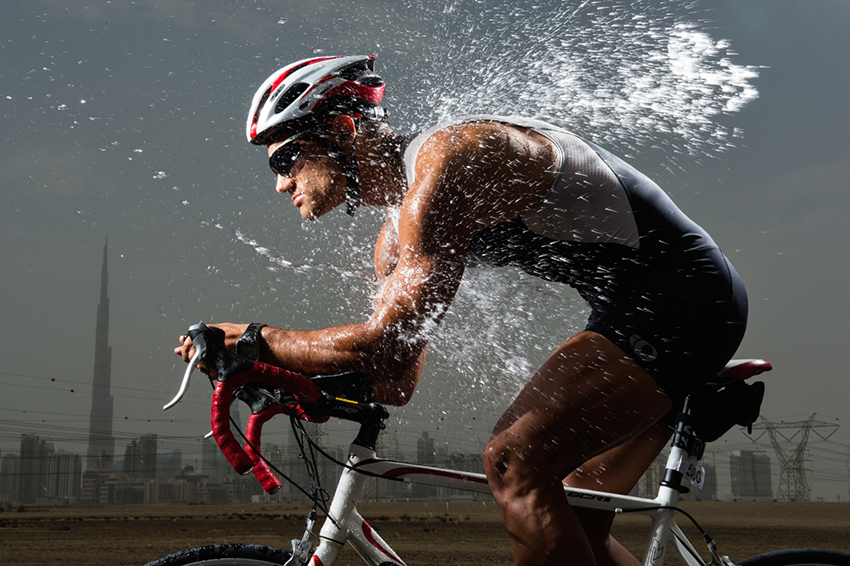
In case you are interested in dynamic cycling photography, consider getting a flash. It will become your reliable helper in low light situations with the fast shutter speed. When you use a flash, it is easier to fix dark shots.
13. Use a High ISO

When you set a high ISO value, you can raise the aperture and shutter speed, reducing the chances of achieving blurry or dark photographs. With the help of this simple trick, you will get a sharper focus on the subject in motion.
14. Experiment with the Panning Technique

To achieve dynamic bike racing photography, take advantage of the panning technique. Try tracking and panning the cyclist with the camera while the shutter is opening and closing. As a result, you will get a clear cyclist and a background with the motion blur.
How to do panning in a proper way? Enable the manual mode and adjust shutter speed, picking values between 1/10s-1/60s. It guarantees that the moving camera will produce a blur. For the blurred background and the clear cyclist, an f/8 aperture will be optimal.
The next step involves pressing the shutter release and rotating with the subject during the opening and the closing of the shutter. Follow all these recommendations and you are sure to get an impressive result.
15. Shoot in Continuous Mode
When you wish to capture the cyclist moving at a high speed, you can enable the continuous shooting mode, also known as burst mode. If you do it, you will be able to take from over 5 shots within a few seconds. Try taking as many shots as possible to pick the most flattering one.
16. Try to Take a Series of Pictures
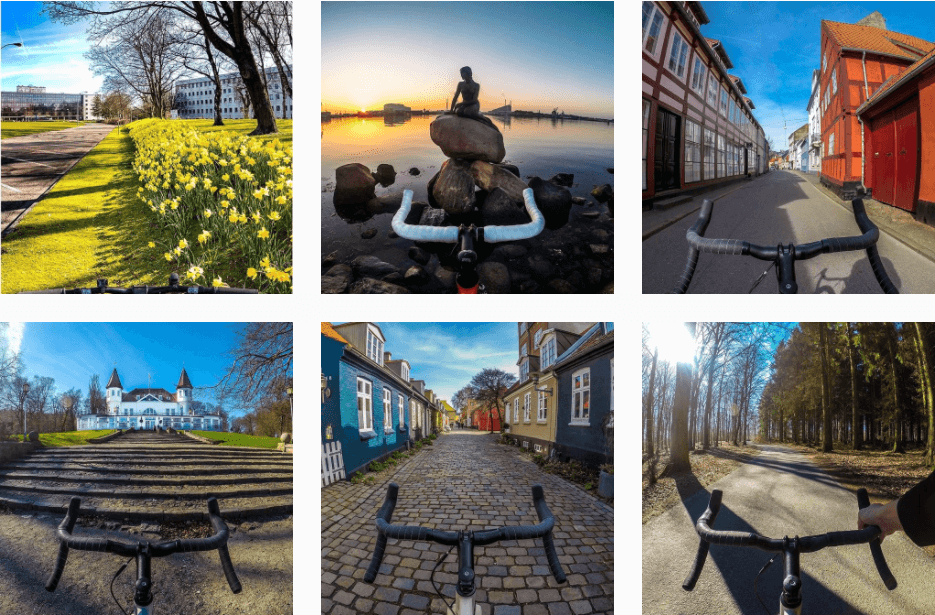
An interesting idea for photography with bike is to activate the burst mode and take multiple pictures simultaneously. As a result, you will get a series of shots that may be displayed side by side. It looks way more eye-catching than a singular static shot.
17. Use Autofocus
Trying to focus every frame is a tiresome task. Don’t give yourself a hard time. Enter AF mode and enable Continuous Autofocus (AI Servo or AFC). It means that the camera will be instantly adapting to the cyclists’ movements. The adaptation happens when the shutter button is half-pressed.
18. Avoid Abrupt Movements
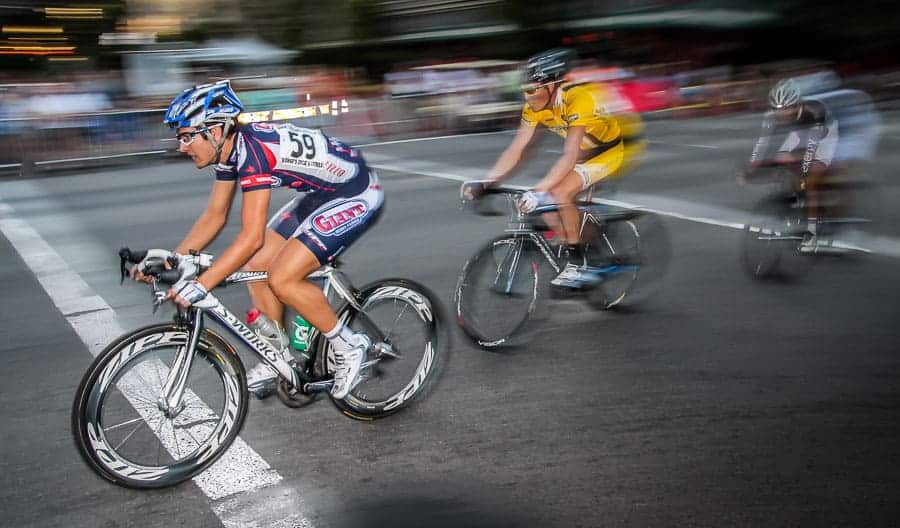
Taking bike photography, it is better to avoid making hasty movements. The action of releasing the shutter button should be smooth. If you do it in a quick and even rough manner, the subjects in the frame may be blurred.
19. Take Pictures in Street Style

As I have mentioned earlier, cycling photography is varied and includes not only racing events. Such shootings may involve poses as well. A street style will ideally suit a posed photo shoot. For instance, ask the cyclist to bring his/her bicycle and take pictures right on the street. The cyclist should pose with the bike, making an emphasis on it.
- Check out more creative photography ideas.
20. Photograph Cyclists at the Usual Training Place

Another interesting idea is to photograph the cyclist in his/her training routine. Or you may not inform the model that you are going to shoot and capture the natural poses and emotions. Take pictures of the entire process and unique results are guaranteed.
21. Take Advantage of Sunrises and Sunsets

The greatest time for photography with bike is during sunset or sunrise. Ask the cyclist to bring his bicycle and start taking captivating shots. For a more interesting composition, shoot next to some water body and put the bike on the ground beside the cyclist. With the sunset as a background, the cyclist and the bike are in shadows while the sunset is illuminated.
22. Go to the Forest Roads

A wonderful background for road cycling photography is the forest. The cyclist should pretend that he/she is riding the bicycle in the middle of the road for the trees to be visible in the frame. The final shots are bound to look magnificent.
23. Bridges

For a posed shooting, suggest the cyclist take pictures on the bridge. The best time for such shots is early morning when there aren’t many people around and no one will get into the frame. Perhaps you will be able to capture the dawn and achieve even more beautiful pictures.
24. Ask a Cyclist to Perform Tricks

If the cyclist is capable of performing different stunts, you should definitely capture it on camera. All kinds of cycling tricks look spectacular in shots.
25. Offer a Cyclist to Get on the Front/Back Wheel

To bring more creativity into your cycling photography, try asking the cyclist to ride only on the front or back wheel of the bike. If the cyclist has never done anything like that, it is better not to risk.
26. Capture the Moments of Training

Training is an integral part of any cyclist’s everyday life. You may take pictures of this process – whether these are regular warming-up exercises or practices before the race. Remarkable shots are guaranteed.
27. Shoot Cycling Couples

Do you know that you can implement plenty of creative couple photo ideas on the bicycle? A couple may be kissing while sitting on the bikes or standing beside them. A couple may gaze in one direction or at each other. Dynamic couple shots taken with the help of the panning technique is a no less creative idea.
28. Take Pictures of a Group of Cyclists

This type of pictures is possible to take during a cycling event or race and an arranged shooting. In the first case, photograph the cyclists while they are racing. As for the arranged shooting, suggest the cyclists stand near each other with the bikes beside them. Moreover, you may try simulating a race for a great shot.
- Check out more group photo ideas.
29. Catch the Cycling Race Finish

When taking bike racing photography, capture the final moments of the race. For instance, it may be the winner crossing the finish line. Zoom in onto his/her face to convey the emotions at that moment.
30. Take Black and White Photos

Take cycling photography in black and white to concentrate on how the lights move in the pic. When you remove the distracting colors, you will be able to observe the way the lights and their levels affect the entire shot.
- Read about tips for black and white photography.
Best Cycling Photographers
Cycling photography isn’t such a widespread genre. Nevertheless, it boasts a number of prominent photographers who are mostly known for shooting in this genre. Now let’s learn about them and their best cycling photos of all time in more detail.
Graham Watson Website
 Graham Watson is a London-based cycling photographer. After studying at Stanley Technical High School, he joined society photographer, Lenare. It helped Graham acquire photography basics, like lighting, exposure, composition, print and film. Then he got interested in cycling, traveling the distance of 20km to London and back every day. As a result of shooting a weekend trip to the 1977 Tour de France in Paris, Graham became a winner of the small photography competition held by the British “Cycling Weekly” magazine. That moment marked the start of his cycling photography career.
Graham Watson is a London-based cycling photographer. After studying at Stanley Technical High School, he joined society photographer, Lenare. It helped Graham acquire photography basics, like lighting, exposure, composition, print and film. Then he got interested in cycling, traveling the distance of 20km to London and back every day. As a result of shooting a weekend trip to the 1977 Tour de France in Paris, Graham became a winner of the small photography competition held by the British “Cycling Weekly” magazine. That moment marked the start of his cycling photography career. 
Jered & Ashley Gruber Instagram
 Jered&AshleyGruberstate that they don’t have a permanent residence. Most of the time, they explore Europe, searching for stories, roads, pictures and their new favorite location. Since Jered and Ashley travel a lot, they manage to snap captivating pictures and share them on their official website for everyone to appreciate the beauty of different places and nature.
Jered&AshleyGruberstate that they don’t have a permanent residence. Most of the time, they explore Europe, searching for stories, roads, pictures and their new favorite location. Since Jered and Ashley travel a lot, they manage to snap captivating pictures and share them on their official website for everyone to appreciate the beauty of different places and nature. 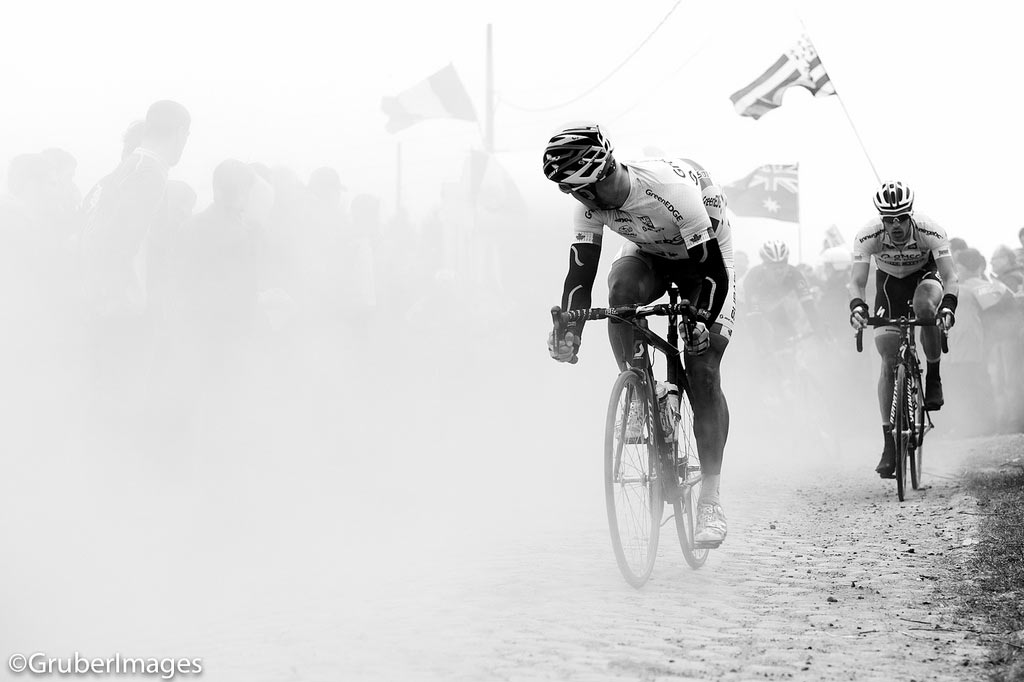
Ben Kristy Instagram

Freebies for Cycling Photography
Now that you know how to take cycling photos, it is time to learn how to enhance them. That’s where our effective picture editing freebies found below will come in handy.
Bokeh


Add dynamics to your cycling shots with the help of this overlay. After applying it, the main subject – the cyclist and the bicycle will be sharper and the background will be blurred a bit. This overlay is absolutely perfect for shots taken outside.
Portrait


This action is suitable for the cases when you need to shoot a cyclist portrait, with a focus on the face and with him/her posing or being in motion. It will enhance the overall colors, neutralizing unnecessary color cast and lowering the noise seamlessly. The action guarantees a natural-looking cyclist portrait with a professional touch.
Color Action


Need to edit a posed picture of a cyclist taken in the city streets? Then you won’t find a better PS action for the task. Being suitable for all street shots, it gives them more warmth, contrast and brightness.
High Contrast


This LR preset increases the contrast and brightness of the shots. That’s exactly what is necessary to achieve in cycling photography editing. But the preset will perfectly suit any other photography genres as well.
Black and White Film


Use this preset to apply stunning black and white colors to cycling photography taken in the streets. It tweaks toning, textures, shapes and contrast for a gorgeous black and white effect.



